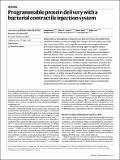| dc.contributor.author | Kreitz, Joseph | |
| dc.contributor.author | Friedrich, Mirco J | |
| dc.contributor.author | Guru, Akash | |
| dc.contributor.author | Lash, Blake | |
| dc.contributor.author | Saito, Makoto | |
| dc.contributor.author | Macrae, Rhiannon K | |
| dc.contributor.author | Zhang, Feng | |
| dc.date.accessioned | 2023-04-06T18:07:59Z | |
| dc.date.available | 2023-04-06T18:07:59Z | |
| dc.date.issued | 2023-03-29 | |
| dc.identifier.uri | https://hdl.handle.net/1721.1/150443 | |
| dc.description.abstract | <jats:title>Abstract</jats:title><jats:p>Endosymbiotic bacteria have evolved intricate delivery systems that enable these organisms to interface with host biology. One example, the extracellular contractile injection systems (eCISs), are syringe-like macromolecular complexes that inject protein payloads into eukaryotic cells by driving a spike through the cellular membrane. Recently, eCISs have been found to target mouse cells<jats:sup>1–3</jats:sup>, raising the possibility that these systems could be harnessed for therapeutic protein delivery. However, whether eCISs can function in human cells remains unknown, and the mechanism by which these systems recognize target cells is poorly understood. Here we show that target selection by the <jats:italic>Photorhabdus</jats:italic> virulence cassette (PVC)—an eCIS from the entomopathogenic bacterium <jats:italic>Photorhabdus asymbiotica</jats:italic>—is mediated by specific recognition of a target receptor by a distal binding element of the PVC tail fibre. Furthermore, using in silico structure-guided engineering of the tail fibre, we show that PVCs can be reprogrammed to target organisms not natively targeted by these systems—including human cells and mice—with efficiencies approaching 100%. Finally, we show that PVCs can load diverse protein payloads, including Cas9, base editors and toxins, and can functionally deliver them into human cells. Our results demonstrate that PVCs are programmable protein delivery devices with possible applications in gene therapy, cancer therapy and biocontrol.</jats:p> | en_US |
| dc.language.iso | en | |
| dc.publisher | Springer Science and Business Media LLC | en_US |
| dc.relation.isversionof | 10.1038/s41586-023-05870-7 | en_US |
| dc.rights | Creative Commons Attribution | en_US |
| dc.rights.uri | http://creativecommons.org/licenses/by/4.0/ | en_US |
| dc.source | Nature | en_US |
| dc.title | Programmable protein delivery with a bacterial contractile injection system | en_US |
| dc.type | Article | en_US |
| dc.identifier.citation | Kreitz, Joseph, Friedrich, Mirco J, Guru, Akash, Lash, Blake, Saito, Makoto et al. 2023. "Programmable protein delivery with a bacterial contractile injection system." Nature. | |
| dc.contributor.department | Massachusetts Institute of Technology. Department of Brain and Cognitive Sciences | en_US |
| dc.relation.journal | Nature | en_US |
| dc.eprint.version | Final published version | en_US |
| dc.type.uri | http://purl.org/eprint/type/JournalArticle | en_US |
| eprint.status | http://purl.org/eprint/status/PeerReviewed | en_US |
| dc.date.updated | 2023-04-06T18:03:38Z | |
| dspace.orderedauthors | Kreitz, J; Friedrich, MJ; Guru, A; Lash, B; Saito, M; Macrae, RK; Zhang, F | en_US |
| dspace.date.submission | 2023-04-06T18:04:02Z | |
| mit.license | PUBLISHER_CC | |
| mit.metadata.status | Authority Work and Publication Information Needed | en_US |
